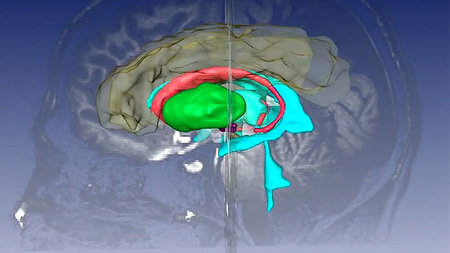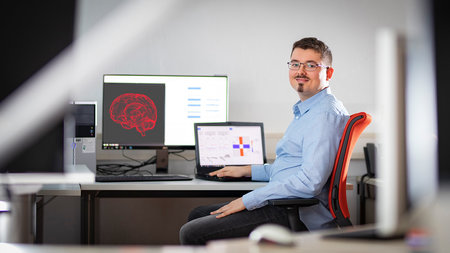Journale
2025 2024 2023 2022 2021 2020 2019 2018 2017 2016 2015 2014 2013 2012 2011 2010 2009 2008 2007 2006 2005 2004 2003 2001 1998 1996
2025
Maith, O., Apenburg, D., Hamker, F.H. (in press)
Pallidal deep brain stimulation enhances habitual behavior in a neuro-computational basal ganglia model during a reward reversal learning task
European Journal of Neuroscience (EJN),
Rudisch, J., Holzhauer, L., Kravanja, K., Hamker, F.H., Voelcker-Rehage, C. (in press)
A systematic review of observational practice for adaptation of reaching movements
npj Science of Learning,
Larisch, R., Hamker, F.H. (2025)
A systematic analysis of the joint effects of ganglion cells, lagged LGN cells, and intercortical inhibition on spatiotemporal processing and direction selectivity
Neural Networks, 186:107273. doi:10.1016/j.neunet.2025.107273.
Evers, K., Farisco, M., Chatila, R., Earp, B.D., Freire, I.T., Hamker, F.H., Nemeth, E., Verschure, P.F.M.J., Khamassi, M. (2025)
Preliminaries to artificial consciousness: a multidimensional heuristic approach
Physics of Life Reviews, 52(3):180-193. doi:10.1016/j.plrev.2025.01.002.
Extern
2024
Hamker, F.H. (2024)
Von der Computational Neuroscience zur NeuroAI: KI nach dem Vorbild der Funktion des Gehirns
Neuroforum, 30(2):21-27.
Extern
Baladron, J., Hamker, F.H. (2024)
Re-thinking the organization of cortico-basal ganglia-thalamo-cortical loops
Cognitive Computation, 16, 2405‐2410. doi:10.1007/s12559-023-10140-9.
Extern
2023
Larisch, R., Vitay, J., Hamker, F.H. (2023)
Detecting anomalies in system logs with a compact convolutional transformer
IEEE Access, 11:113464‐113479. doi:10.1109/ACCESS.2023.3323252.
Burkhardt, M., Bergelt, J., Goenner, L., Dinkelbach, H.Ü, Beuth, F., Schwarz, A., Bicanski, A., Burgess, N., Hamker, F.H. (2023)
A Large-scale Neurocomputational Model of Spatial Cognition Integrating Memory with Vision
Neural Networks, 167:473-488. doi:10.1016/j.neunet.2023.08.034.
Extern
Maith, O., Baladron, J., Einhäuser, W., Hamker, F.H. (2023)
Exploration behavior after reversals is predicted by STN-GPe synaptic plasticity in a basal ganglia model
iScience, 26(5):106599. doi:10.1016/j.isci.2023.106599.
Extern
Baladron, J., Vitay, J., Fietzek, T., Hamker, F.H. (2023)
The contribution of the basal ganglia and cerebellum to motor learning: a neuro-computational approach
PLOS Computational Biology, 19(4): e1011024. doi:10.1371/journal.pcbi.1011024.
Extern
2022
Meier, J.M., Perdikis, D., Blickensdörfer, A., Stefanovski, L., Liu, Q., Maith, O., Dinkelbach, H.Ü., Baladron, J., Hamker, F.H., Ritter, P. (2022)
Virtual deep brain stimulation: Multiscale co-simulation of a spiking basal ganglia model and a whole-brain mean-field model with The Virtual Brain
Experimental Neurology, 354:11411. doi:10.1016/j.expneurol.2022.114111.
Extern
Dinkelbach, H.Ü, Bouhlal, B.-E., Vitay, J., Hamker, F.H. (2022)
Auto-selection of an Optimal Sparse Matrix Format in the Neuro-simulator ANNarchy
Frontiers in Neuroinformatics, 16:877945. doi:10.3389/fninf.2022.877945.
Extern
Maith, O., Dinkelbach, H.Ü, Baladron, J., Vitay, J., Hamker, F.H. (2022)
BOLD monitoring in the neural simulator ANNarchy
Frontiers in Neuroinformatics, 16. doi:10.3389/fninf.2022.790966.
Scholl, C., Baladron, J., Vitay, J., Hamker, F.H. (2022)
Enhanced habit formation in Tourette patients explained by shortcut modulation in a hierarchical cortico-basal ganglia model
Brain Structure & Function, 227(3):1031-1050. doi:10.1007/s00429-021-02446-x.
Extern
2021
Larisch, R., Teichmann, M., Gönner, L., Hamker, F.H. (2021)
Sensory coding and contrast invariance emerge from the control of plastic inhibition over emergent selectivity
PLOS Computational Biology, 17(11):e1009566. doi:10.1371/journal.pcbi.1009566.
Extern
Novin, S., Fallah, A., Rashidi, S., Beuth, F., Hamker, F.H. (2021)
A neuro-computational model of visual attention with multiple attentional control sets
Vision Research, 189:104-118. doi:10.1016/j.visres.2021.08.009.
PDF-document
Forch, V., Hamker, F.H. (2021)
Building and Understanding the Minimal Self
Frontiers Psychology, 12:716982. doi:10.3389/fpsyg.2021.716982.
Extern
Krumm, D., Kuske, N., Buder, J., Neubert, M., Odenwald, S., Hamker, F.H. (2021)
Determining push-off forces in speed skating imitation drills
Sports Engineering, 24:25. doi:10.1007/s12283-021-00362-1.
Extern
Teichmann, M., Larisch, R., Hamker, F.H. (2021)
Performance of biologically grounded models of the early visual system on standard object recognition tasks
Neural Networks, 144:210-228. doi:10.1016/j.neunet.2021.08.009.
Extern
Maith, O., Schwarz, A., Hamker, F.H. (2021)
Optimal Attention Tuning in a neuro-computational Model of the Visual Cortex - Basal Ganglia - Prefrontal Cortex Loop
Neural Networks, 142:534-547. doi:10.1016/j.neunet.2021.07.008.
2020
Goenner, L., Maith, O., Koulouri, I., Baladron, J., Hamker, F.H. (2020)
A spiking model of basal ganglia dynamics in stopping behavior supported by Arkypallidal neurons
European Journal of Neuroscience, 53(7):2296-2321. doi:10.1111/ejn.15082.
Yahya, K. (2020)
The basal ganglia corticostriatal loops and conditional learning
Reviews in the Neurosciences, 32(2):181-190. doi:10.1515/revneuro-2020-0047.
Extern
Forch, V., Vitay, J., Hamker, F.H. (2020)
Recurrent spatial attention for facial emotion recognition
Chemnitzer Informatik-Berichte, ISSN 0947-5125, CSR-20-01:1-8.
Extern
Nassour, J., Hamker, F.H., Cheng, G. (2020)
High-Performance Perpendicularly-Enfolded-Textile Actuators for Soft Wearable Robots: Design and Realization
IEEE Transactions on Medical Robotics and Bionics, 2(3):309-319. doi:10.1109/TMRB.2020.3012131.
Extern
Nassour, J., Amirabadi, H.G., Wheabby, S., Al Ali, A., Lang, H., Hamker, F.H. (2020)
A Robust Data-Driven Soft Sensory Glove for Human Hand Motions Identification and Replication
IEEE Sensors Journal, doi:10.1109/JSEN.2020.3001982.
Maith, O., Villagrasa Escudero, F., Dinkelbach, H., Baladron, J., Horn, A., Irmen, F., Kühn, A., Hamker, F.H. (2020)
A computational model-based analysis of basal ganglia pathway changes in Parkinson's disease inferred from resting state fMRI
European Journal of Neuroscience, 53(7):2278-2295. doi:10.1111/ejn.14868.
Baladron, J., Hamker, F.H. (2020)
Habit learning in hierarchical cortex - basal ganglia loops
European Journal of Neuroscience, 52(12):4613-4638. doi:10.1111/ejn.14730.
2019
Larisch, R. (2019)
[Re] Connectivity reflects coding a model of voltage-based STDP with homeostasis
ReScience C, 5(3). doi:10.5281/zenodo.3538217.
Abadi, A. K., Yahya, K., Amini, M., Friston, K., Heinke, D. (2019)
Excitatory versus inhibitory feedback in Bayesian formulations of scene construction
Journal of The Royal Society, 16(154). doi:10.1098/rsif.2018.0344.
Extern
Nassour, J. (2019)
Marionette-based programming of a soft textile inflatable actuator
Sensors and Actuators A: Physical, 291:93-98. doi:10.1016/j.sna.2019.03.017.
Bergelt, J., Hamker, F.H. (2019)
Spatial updating of attention across eye movements: A neuro-computational approach
Journal of Vision, 19(7):10, 1-23. doi:10.1167/19.7.10.
Supplementary Material
Kübler, D., Schroll, H., Hamker, F.H., Joutsa, J., Kühn, A.A. (2019)
The effect of dopamine on response inhibition in Parkinson's disease relates to age-dependent patterns of nigrostriatal degeneration
Parkinsonism and Related Disorders, 63:185-190. doi:10.1016/j.parkreldis.2019.02.003.
Nassour, J., Tran, D.H., Atoofi, P., Hamker, F.H. (2019)
Concrete Action Representation Model: from Neuroscience to Robotics
IEEE Transactions on Cognitive and Developmental Systems, 12:272-284. doi:10.1109/TCDS.2019.2896300.
Extern
Baladron, J., Nambu, A., Hamker, F.H. (2019)
The subthalamic nucleus - external globus pallidus loop biases exploratory decisions towards known alternatives: A neuro-computational study
European Journal of Neuroscience, 49:754-767. doi:10.1111/ejn.13666.
Extern
2018
Duy Hoa, T., Hamker, F.H., Nassour, J. (2018)
A Humanoid Robot Learns to Recover Perturbation During Swinging Motion
IEEE Transactions on Systems, Man, and Cybernetics: Systems, 1-12. doi:10.1109/tsmc.2018.2884619.
Villagrasa, F., Baladron, J., Vitay, J., Schroll, H., Antzoulatos, E. G., Miller, Earl K., Hamker, F.H. (2018)
On the role of cortex-basal ganglia interactions for category learning: A neuro-computational approach
Journal of Neuroscience, 38(44):9551-9562. doi:10.1523/JNEUROSCI.0874-18.2018.
Atoofi, P., Hamker, F.H., Nassour, J. (2018)
Learning of Central Pattern Generator Coordination in Robot Drawing
Frontiers in Neurorobotics, 12:44. doi:10.3389/fnbot.2018.00044.
Extern
Neumann, W.-J., Schroll, H., de Almeida Marcelino, A.L., Horn, A., Ewert, S., Irmen, F., Krause, P., Schneider, G.-H., Hamker, F.H., Kühn, A. (2018)
Functional segregation of basal ganglia pathways in Parkinson's disease
Brain, 141(9):2655-2669. doi:10.1093/brain/awy206.
PDF-document
Schroll, H., Horn, A., Runge, J., Lipp, A., Schneider, G.-H., Krauss, J., Hamker, F.H., Kühn, A. (2018)
Reinforcement magnitudes modulate subthalamic beta band activity in patients with Parkinson's disease
Scientific Reports, 8(1):8621. doi:10.1038/s41598-018-26887-3.
2017
Gönner, L., Vitay, J., Hamker, F.H. (2017)
Predictive Place-Cell Sequences for Goal-Finding Emerge from Goal Memory and the Cognitive Map: A Computational Model
Frontiers in Computational Neuroscience, 11:84. doi:10.3389/fncom.2017.00084.
Extern
Irmen, F., Huebl, J., Schroll, H., Brücke, Ch., Schneider, G.-H., Hamker, F.H., Kühn, A. (2017)
Subthalamic nucleus stimulation impairs emotional conflict monitoring in Parkinson's Disease
Social Cognitive and Affective Neuroscience, 12(10):1594-1604. doi:10.1093/scan/nsx090.
Extern
Ziesche, A., Bergelt, J., Deubel, H., Hamker, F.H. (2017)
Pre- and post-saccadic stimulus timing in Saccadic Suppression of Displacement - a computational model
Vision Research, 138:1-11. doi:10.1016/j.visres.2017.06.007.
Extern
Hartmann, T.S., Zirnsak, M., Marquis, M., Hamker, F.H., Moore, T. (2017)
Two types of receptive field dynamics in area V4 at the time of eye movements?
Frontiers in Systems Neuroscience, 11:13. doi:10.3389/fnsys.2017.00013.
Extern
2016
Vitay, J. (2016)
Robust timing and motor patterns by taming chaos in recurrent neural networks
ReScience 2(1), doi:10.5281/zenodo.159545.
PDF-document
Schroll, H., Hamker, F.H. (2016)
Basal ganglia dysfunctions in movement disorders: What can be learned from computational simulations
Movement Disorders, 31:1591-1601. doi:10.1002/mds.26719.
Extern
Bergelt, J., Hamker, F. H. (2016)
Suppression of displacement detection in the presence and absence of eye movements: A neuro-computational perspective.
Biological Cybernetics, 110:81-89. doi:10.1007/s00422-015-0677-z.
Extern
2015
Vitay, J., Dinkelbach, H.Ü., Hamker F.H. (2015)
ANNarchy: a code generation approach to neural simulations on parallel hardware
Frontiers in Neuroinformatics, 9, 19. doi:10.3389/fninf.2015.00019.
Extern
Lappe, M., Hamker, F.H. (2015)
Peri-saccadic compression to two locations in a two-target choice saccade task
Frontiers in Systems Neuroscience, 9:135. doi:10.3389/fnsys.2015.00135.
Extern
Kermani Kolankeh, A., Teichmann, M., Hamker, F.H. (2015)
Competition improves robustness against loss of information
Frontiers in Computational Neuroscience, 9:35. doi:10.3389/fncom.2015.00035.
Extern
Liebold, B., Richter, R., Teichmann, M., Hamker, F.H., Ohler, P. (2015)
Human Capacities for Emotion Recognition and their Implications for Computer Vision
i-com, 14(2):126-137. doi:10.1515/icom-2015-0032.
Schroll, H., Horn, A., Gröschel, C., Brücke, C., Lütjens, G., Schneider, G.-H., Krauss, J. K., Kühn, A. A., Hamker, F. H. (2015)
Differential contributions of the globus pallidus and ventral thalamus to stimulus-response learning in humans
NeuroImage, 122, 233-245. doi:10.1016/j.neuroimage.2015.07.061.
Beuth, F., Hamker, F. H. (2015)
A mechanistic cortical microcircuit of attention for amplification, normalization and suppression
Vision Research, 116, 241-257. doi:10.1016/j.visres.2015.04.004.
PDF-document
Supplementary Material
Ebner, C., Schroll, H., Winther, G., Niedeggen, M., Hamker, F.H. (2015)
Open and closed cortico-subcortical loops: A neuro-computational account of access to consciousness in the distractor-induced blindness paradigm
Consciousness and Cognition, 35:295-307. doi:10.1016/j.concog.2015.02.007.
PDF-document
Baladron, J., Hamker, F.H. (2015)
A spiking neural network based on the basal ganglia functional anatomy
Neural Networks, 67:1-13. doi:10.1016/j.neunet.2015.03.002.
PDF-document
Schroll, H., Beste, C., Hamker, F.H. (2015)
Combined lesions of direct and indirect basal ganglia pathways but not changes in dopamine levels explain learning deficits in patients with Huntington's disease
European Journal of Neuroscience, 41:1227-1244. doi:10.1111/ejn.12868.
PDF-document
Dinkelbach, H.Ü., Schuster, J., Hamker, F.H. (2015)
Reinforcement Learning zur Planung von Arbeitsprozessen
Industrie 4.0 Management, 31(1), 9-12.
Hamker, F.H. (2015)
Spatial Cognition of humans and brain-like artificial agents
Künstliche Intelligenz, 29, 83-88. doi:10.1007/s13218-014-0338-8.
Extern
2014
Müller, N., Truschzinski, M., Fink, V., Schuster, J., Dinkelbach, H.Ü., Heft, V., Kronfeld, Th., Rau, C., Spitzhirn, M. (2014)
The Smart Virtual Worker
Technische Sicherheit, Springer VDI Verlag. 7-8, 32-35.
Verleger, R., Koerbs, A., Graf, J., Smigasiewicz, K., Schroll, H., Hamker, F.H. (2014)
Patients with Parkinson's disease are less affected than healthy persons by relevant response-unrelated features in visual search
Neuropsychologia, 62, 38-47. doi:10.1016/j.neuropsychologia.2014.07.004.
PDF-document
Antonelli, M., Gibaldi, A., Beuth, F., Duran, A. J., Canessa, A., Chessa, M., Solari, F., del Pobil, P., Hamker, F., Chinellato, E., Sabatini, S. P. (2014)
A Hierarchical System for a Distributed Representation of the Peripersonal Space of a Humanoid Robot
IEEE Transactions on Autonomous Mental Development, 6(4), 259-273. doi:10.1109/TAMD.2014.2332875.
PDF-document
Vitay, J., Hamker, F.H. (2014)
Timing and expectation of reward: a neuro-computational model of the afferents to the ventral tegmental area
Frontiers in Neurorobotics, 8:4. doi:10.3389/fnbot.2014.00004.
Extern
Ziesche, A., Hamker, F.H. (2014)
Brain circuits underlying visual stability across eye movements - converging evidence for a neuro-computational model of area LIP.
Frontiers in Computational Neuroscience, 8(25), 1-15. doi:10.3389/fncom.2014.00025.
Extern
Schroll, H., Vitay, J., Hamker, F.H. (2014)
Dysfunctional and Compensatory Synaptic Plasticity in Parkinson's Disease.
European Journal of Neuroscience, 39:688-702. doi:10.1111/ejn.12434.
PDF-document
2013
Schroll H., Hamker, F.H. (2013)
Computational models of basal-ganglia pathway functions: Focus on functional neuroanatomy
Frontiers in Systems Neuroscience, 7:122. doi:10.3389/fnsys.2013.00122.
Extern
Verleger R., Schroll H., Hamker F.H. (2013)
The Unstable Bridge from Stimulus Processing to Correct Responding in Parkinson's Disease
Neuropsychologia, 51(13):2512-2525. doi:10.1016/j.neuropsychologia.2013.09.017.
PDF-document
2012
Dinkelbach, H.Ü, Vitay, J., Beuth, F., Hamker, F.H. (2012)
Comparison of GPU- and CPU-implementations of mean-firing rate neural networks on parallel hardware.
Network: Computation in Neural Systems., 23(4): 212-236. doi:10.3109/0954898X.2012.739292.
PDF-document
Hamker, F.H. (2012)
Neural learning of cognitive control
Künstliche Intelligenz, 26: 397-401. doi: 10.1007/s13218-012-0210-7.
PDF-document
Trapp, S., Schroll, H., Hamker, F.H. (2012)
Open and Closed loops: A computational approach to Attention and Consciousness
Advances in Cognitive Psychology, 8(1): 1-8. doi:10.5709/acp-0096-y.
PDF-document
Teichmann, M., Wiltschut, J., Hamker, F.H. (2012)
Learning invariance from natural images inspired by observations in the primary visual cortex
Neural Computation, 24(5): 1271-1296. doi:10.1162/NECO_a_00268.
Extern
Schroll, H, Vitay, J, Hamker, F.H. (2012)
Working memory and response selection: A computational account of interactions among cortico-basal ganglio-thalamic loops.
Neural Networks, 26: 59-74. doi:10.1016/j.neunet.2011.10.008.
PDF-document
2011
Zirnsak, M., Gerhards, R., Kiani, R., Lappe, M., Hamker, F.H. (2011)
Anticipatory Saccade Target Processing and the Pre-saccadic Transfer of Visual Features
Journal of Neuroscience, 31(49):17887-17891.
PDF-document
Kermani Kolankeh, A., Spitsyn, V.G, Hamker, F.H. (2011)
Finding parameters and removing the DC component of Gabor Filter for Image processing
Bulletin of Tomsk Polytechnic University, 318(5):57.
PDF-document
Kiefer, M., Ansorge, U., Haynes, J.-D., Hamker, F.H., Mattler, U., Verleger, R., Niedeggen, M. (2011)
Neuro-cognitive mechanisms of conscious and unconscious visual perception: From a plethora of phenomena to general principles
Advances in Cognitive Psychology, 7: 55-67.
PDF-document
Vitay, J., Hamker, F. H. (2011)
A Neuroscientific View on the Role of Emotions in Behaving Cognitive Agents.
Künstliche Intelligenz, 25: 235-244.
PDF-document
Zirnsak, M., Beuth, F., Hamker, F. H. (2011)
Split of spatial attention as predicted by a systems-level model of visual attention
European Journal of Neuroscience, 33: 2035-2045.
PDF-document
Ziesche, A., Hamker, F. H. (2011)
A computational Model for the Influence of Corollary Discharge and Proprioception on the Perisaccadic Mislocalization of Briefly Presented Stimuli in Complete Darkness
Journal of Neuroscience, 31(48): 17392-17405. doi:10.1523/JNEUROSCI.3407-11.2011.
PDF-document
Hamker, F. H., Zirnsak, M., Ziesche, A., Lappe, M. (2011)
Computational models of spatial updating in peri-saccadic perception
Phil. Trans. R. Soc. B (2011), 366: 554-571. doi:10.1098/rstb.2010.0229.
PDF-document
2010
Vitay, J., Hamker, F. H. (2010)
A computational model of basal ganglia and its role in memory retrieval in rewarded visual memory tasks.
Frontiers in Computational Neuroscience, 4(13): 1-18.
Extern
Zirnsak, M., Lappe, M., Hamker, F. H. (2010)
The spatial distribution of receptive field changes in a model of peri-saccadic perception: predictive remapping and shifts towards the saccade target.
Vision Research, 50:1328-1337. doi:10.1016/j.visres.2010.02.002.
PDF-document
Zirnsak, M., Hamker, F. H. (2010)
Attention Alters Feature Space in Motion Processing.
Journal of Neuroscience, 30(20):6882-6890. doi:10.1523/JNEUROSCI.3543-09.2010.
PDF-document
2009
Vitay, J., Fix, J., Beuth, F., Schroll, H., Hamker, F. H. (2009)
Biological Models of Reinforcement Learning.
Künstliche Intelligenz, 3:12-18.
PDF-document
Dubois, J., Hamker, F.H., VanRullen, R. (2009)
Attentional selection of noncontiguous locations: The spotlight is only transiently split.
Journal of Vision, 9(5):3, 1-11.
PDF-document
Wiltschut, J., Hamker, F.H. (2009)
Efficient Coding correlates with spatial frequency tuning in a model of V1 receptive field organization.
Visual Neuroscience, 26:21-34.
PDF-document
2008
Vitay, J., Hamker, F.H. (2008)
Sustained activities and retrival in a computational model of perirhinal cortex.
Journal of Cognitive Neuroscience, 20(11): 1993-2005.
PDF-document
Georg, K., Hamker, F. H., and Lappe, M. (2008)
Influence of adaptation state and stimulus luminance on peri-saccadic localization.
J. Vision, 8(1):15, 1-11.
PDF-document
Hamker, F.H., Zirnsak, M., Calow, D., Lappe, M. (2008)
The peri-saccadic perception of objects and space.
PLOS Computational Biology, 4(2):e31. doi:10.1371/journal.pcbi.0040031.
PDF-document
Hamker, F.H., Zirnsak, M., Lappe, M. (2008)
About the influence of post-saccadic mechanisms for visual stability on peri-saccadic compression of object location.
Journal of Vision, 8(14):1, 1-13.
PDF-document
2007
Hamker, F.H., Wiltschut, J. (2007)
Hebbian learning in a model with dynamic rate-coded neurons: an alternative to the generative model approach for learning receptive fields from natural scenes.
Network, Computation in Neural Systems, 18: 249-266.
PDF-document
Hamker, F. H. (2007)
The mechanisms of feature inheritance as predicted by a systems-level model of visual attention and decision making.
Advances in Cognitive Psychology, 3: 111-123.
PDF-document
2006
Hamker, F. H., Zirnsak, M. (2006)
V4 receptive field dynamics as predicted by a systems-level model of visual attention using feedback from the frontal eye field.
Neural Networks, 19: 1371-1382. doi:10.1016/j.neunet.2006.08.006.
PDF-document
Hamker, F. H. (2006)
Modeling feature-based attention as an active top-down inference process.
BioSystems, 86: 91-99.
PDF-document
2005
Hamker, F. H. (2005)
The emergence of attention by population-based inference and its role in distributed processing and cognitive control of vision.
Journal for Computer Vision and Image Understanding, Special Issue on Attention and Performance in Computer Vision, 100: 64-106.
PDF-document
Hamker, F. H. (2005)
A computational model of visual stability and change detection during eye movements in real world scenes.
Visual Cognition, 12: 1161-1176.
PDF-document
Hamker, F. H. (2005)
The Reentry Hypothesis: The Putative Interaction of the Frontal Eye Field, Ventrolateral Prefrontal Cortex, and Areas V4, IT for Attention and Eye Movement.
Cerebral Cortex, 15: 431-447.
PDF-document
2004
Hamker, F. H. (2004)
A dynamic model of how feature cues guide spatial attention.
Vision Research, 44: 501-521.
PDF-document
Hamker, F. H. (2004)
Predictions of a model of spatial attention using sum- and max-pooling functions.
Neurocomputing, 56C: 329-343.
PDF-document
2003
Hamker, F. H. (2003)
The reentry hypothesis: linking eye movements to visual perception.
Journal of Vision, 11: 808-816.
PDF-document
2001
Hamker, F. H. (2001)
Life-long learning Cell Structures - continuously learning without catastrophic interference.
Neural Networks, 14: 551-573.
PDF-document
1998
Heinke, D., Hamker, F. H. (1998)
Comparing Neural Networks: A Benchmark on Growing Neural Gas, Growing Cell Structures, and Fuzzy ARTMAP.
IEEE Transactions on Neural Networks, 9: 1279-1291.
PDF-document
1996
Hamker, F. H., Gross, H.-M. (1996)
Region Finding for Attention Control in Consideration of Subgoals.
Neural Network World. International Journal on Neural and Mass-Parallel Computing and Information Systems, 6: 305-313.





